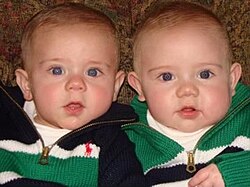Twin
Twins are two babies that are born at the same time.
Human twins are two people that shared a single pregnancy, and one is normally born quickly after the first.
Types of twins
There are 2 types of twins. They are:
Fraternal twins
Fraternal twins are also known as "non-identical twins" or dizygotic twins. They happen when two ova are released from the ovary at the same time, and each is fertilized by a different sperm. This results in the birth of fraternal twins. They can be of different sexes. Genetically, they are no more similar than any two siblings.
Identical twins
Identical twins or monozygotic twins: A single ovum is fertilized to form one zygote. This zygote later splits, and each half of the zygote becomes a twin. The twins have the same genes.
Variations
There are five variations of twinning that occur commonly. The frequency varies in different populations.[1] The three most common variations are all fraternal, meaning the two twins are not from the same egg:
- (1) male-female twins are the most common result, at about 41% of all twins born;
- (2) female fraternal twins (sometimes called sororal twins), about 20%;
- (3) male fraternal twins, about 19%.
The last two variations are identical twins, which means they come from one single egg that split later:
- (4) female identical twins (about 10%) and
- (5) (least common) male identical twins (about 10%).
Other animals
Twinning is common in many other species, such as cats, sheep, and ferrets. Twinning occurs in cattle about 1-4% of the time, and research is being done to improve the chances of twins being born. If an animal has twins it can be more profitable for the breeder, especially if there is a smaller chance of miscarriage.
Twin Media
Identical twins can be difficult to visually distinguish especially when young, as demonstrated by brothers Billy and Bobby Mauch.
Austrian TV host Mirjam Weichselbraun (right) and her fraternal twin Melanie look very similar but with a significant difference in height.
Despite being genetically identical, twins Mark and Scott Kelly are distinguishable from each other.
A pair of female ere ibeji twin figures (early 20th-century) in the permanent collection of The Children's Museum of Indianapolis. The Yoruba people have the highest dizygotic twinning rate in the world.
Chang and Eng Bunker, born in Siam (now Thailand) in 1811, were the origin of the term "Siamese twins".








